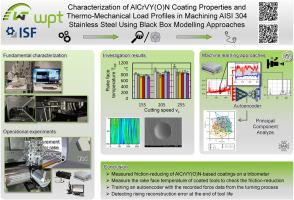用黑箱建模方法表征AlCrVY(O)N涂层性能和加工AISI 304不锈钢时的热机械负荷分布
IF 6.1
1区 工程技术
Q1 ENGINEERING, MECHANICAL
引用次数: 0
摘要
加工过程中普遍存在的热-机械负荷集体显著影响涂层硬质合金刀具的磨损行为,从而影响许多工业价值链的生产率和可持续性。与传统涂层相比,AlCrVY(O)N涂层具有更低的摩擦和更高的高温热稳定性,因此在减少刀具磨损方面具有巨大的潜力。然而,由于摩擦、温度和磨损机制之间复杂的相互作用,这种涂层系统的进一步发展仍然是必不可少的。此外,使用基于工艺数据的黑盒方法检测刀具磨损,可以对加工过程中的磨损过程和涂层行为提供有价值的见解。在这项研究中,AlCrVY(O)N涂层与TiAlN涂层在不同的切削参数下进行了基准测试,以评估其性能。切削参数的变化允许在不同负荷水平下对涂层进行研究。利用加工过程中采集的传感器数据训练长短期记忆自编码器(LSTM)进行刀具磨损分析。基础研究表明,涂层具有均匀的化学成分和35 GPa左右的高硬度值。然而,切削试验表明,与TiAlN涂层相比,使用AlCrVY(O)N涂层并没有显著降低前表面的温度。所开发的lstm自编码器通过分析涂层性能变化引起的重建误差和潜在空间表示的差异,成功地识别了刀具磨损。本文章由计算机程序翻译,如有差异,请以英文原文为准。

Characterization of AlCrVY(O)N coating properties and thermo-mechanical load profiles in machining AISI 304 stainless steel using black box modelling approaches
The thermo-mechanical load collective prevailing during machining significantly influences the wear behavior of coated carbide tools and thereby impacts the productivity and sustainability of many industrial value chains. AlCrVY(O)N coatings show a significant potential for reducing tool wear due to their lower friction and enhanced thermal stability at elevated temperatures compared to conventional coatings. However, due to the complex interplay between friction, temperature, and wear mechanisms, further development of such coating systems remains essential. Additionally, detecting tool wear using black box approaches based on process data provides valuable insights into the wear process and coating behavior during machining operations. In this study, AlCrVY(O)N coatings were benchmarked against TiAlN coatings under varying cutting parameters to evaluate their performance. The variation in cutting parameters allowed for an investigation of coatings under different load levels. Sensor data collected during machining was used to train a long short-term memory autoencoder (LSTM) for analyzing the tool wear. Fundamental investigations revealed that the applied coatings exhibit a homogeneous chemical composition and high hardness values around 35 GPa. However, cutting tests showed that the temperatures on the rake face were not significantly reduced when using AlCrVY(O)N coatings compared to TiAlN coatings. The developed LSTM-autoencoder successfully identified tool wear by analyzing differences in the reconstruction error and latent space representations caused by variations in coating properties.
求助全文
通过发布文献求助,成功后即可免费获取论文全文。
去求助
来源期刊

Wear
工程技术-材料科学:综合
CiteScore
8.80
自引率
8.00%
发文量
280
审稿时长
47 days
期刊介绍:
Wear journal is dedicated to the advancement of basic and applied knowledge concerning the nature of wear of materials. Broadly, topics of interest range from development of fundamental understanding of the mechanisms of wear to innovative solutions to practical engineering problems. Authors of experimental studies are expected to comment on the repeatability of the data, and whenever possible, conduct multiple measurements under similar testing conditions. Further, Wear embraces the highest standards of professional ethics, and the detection of matching content, either in written or graphical form, from other publications by the current authors or by others, may result in rejection.
 求助内容:
求助内容: 应助结果提醒方式:
应助结果提醒方式:


